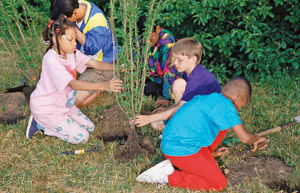Earth Day 2007
by William Borden
This article was originally published in March 2007

For each of us, Earth Day reminds us of our role in protecting this wondrous, delicate planet.
(March 2007) — This year, International Earth Day marks its 27th anniversary on March 21. The U.S. Earth Day celebration is coming up on April 22.
Although the glamour and media coverage of years past may not be as evident today, Earth Day celebrations will take place in neighborhoods, schools, college campuses and cities worldwide, including Seattle.
The reason for the diminished hoopla? Some say the environmental movement is past its prime, but public polls disagree. Last summer, an L.A. Times/Bloomberg poll asked, “Do you think improving the environment conflicts with economic growth, or do you think improving the environment does not have to conflict with economic growth?” Seventy percent said the two need not conflict.
Instead, the movement is growing. Washington state’s mélange of concerned citizens, responsive policy makers, forward-thinking foundations, progressive businesses and Earth Share of Washington nonprofits has led to pesticide bans in public schools, an upsurge in “green buildings,” climate protection measures, reforms to reduce electronic waste, hundreds of thousands of volunteer hours spent restoring our natural landscapes, and the list goes on.
Have we restored Eden? Of course not. More than ever, each of us bears the responsibility of educating ourselves, our friends and colleagues about the benefits of healthy people, animals, plants, air, water and soil. From those elements healthy communities spring.
Earth Day’s origin and the beginning of the modern environmental movement can be traced back to Rachel Carson’s 1962 classic, “Silent Spring.” Polluted air from industrial plants threatened our cities; little or nothing was done to curb waste dumped directly into our waterways; the word “conservation” was spoken principally by academics and a handful of well-intentioned policy makers.
By 1969, when Ohio’s Cuyahoga River caught fire, and an oil spill befouled Santa Barbara, citizens had had enough.
Wisconsin Senator Gaylord Nelson stood before an audience in Seattle in 1969 and announced his intention to organize a grassroots public demonstration on behalf of the environment, planned for the spring of 1970. Nelson tapped volunteers and hired a young Stanford graduate, Denis Hayes, to coordinate nationwide activities.
Hayes, now president of the Seattle-based Bullitt Foundation, recalls his initial response to being selected to organize the first Earth Day, “I’d arranged to meet with Senator Nelson to try to organize Harvard. If the meeting went well, I intended to suggest my willingness to take responsibility for Boston.
Senator Nelson caught me completely off guard when he asked me to organize the United States! It took me about 30 seconds to decide to drop out of graduate school, and my life has never been the same since.”
Protests, demonstrations and teach-ins took aim at pollution and related causes. The city of Miami held a huge, car-free “Dead Orange Parade,” symbolizing the effects of local pollution on citrus crops. Celebrities, such as Paul Newman and Ali McGraw, and more than a million other people filled the Great Lawn in New York’s Central Park.
Earth Day caught the public’s attention, and politicians responded with a flurry of national legislation: Congress adopted the Clean Air Act, the Clean Water Act, the Safe Drinking Water Act, the Endangered Species Act, and President Nixon established the U.S. Environmental Protection Agency.
Recycling programs began in cities and towns. Gone were detergents with phosphates, which cause eutrophication of lakes and rivers. Oil companies removed lead from gasoline. For several years, the public turned green.
Nineteen years later, Hayes was at it again, this time organizing a worldwide Earth Day observance. By the time it was done, 144 nations participated in the 1990 event. People will observe Earth Day in various ways: Organizing clean-up of a park, inviting a speaker to address their religious service, and working with schools to encourage bicycling.
Some view Earth Day as an opportunity to make resolutions: To plant a tree, carpool with neighbors, or create a compost area in the backyard. For each of us, Earth Day reminds us of our role in protecting this wondrous, delicate planet.
William Borden is Executive Director of Earth Share of Washington, which represents more than 60 environmental organizations. If your company doesn’t currently offer Earth Share as a choice for payroll contributions, have your Human Resources manager contact info@esw.org.
